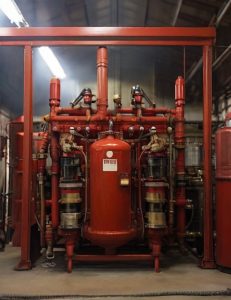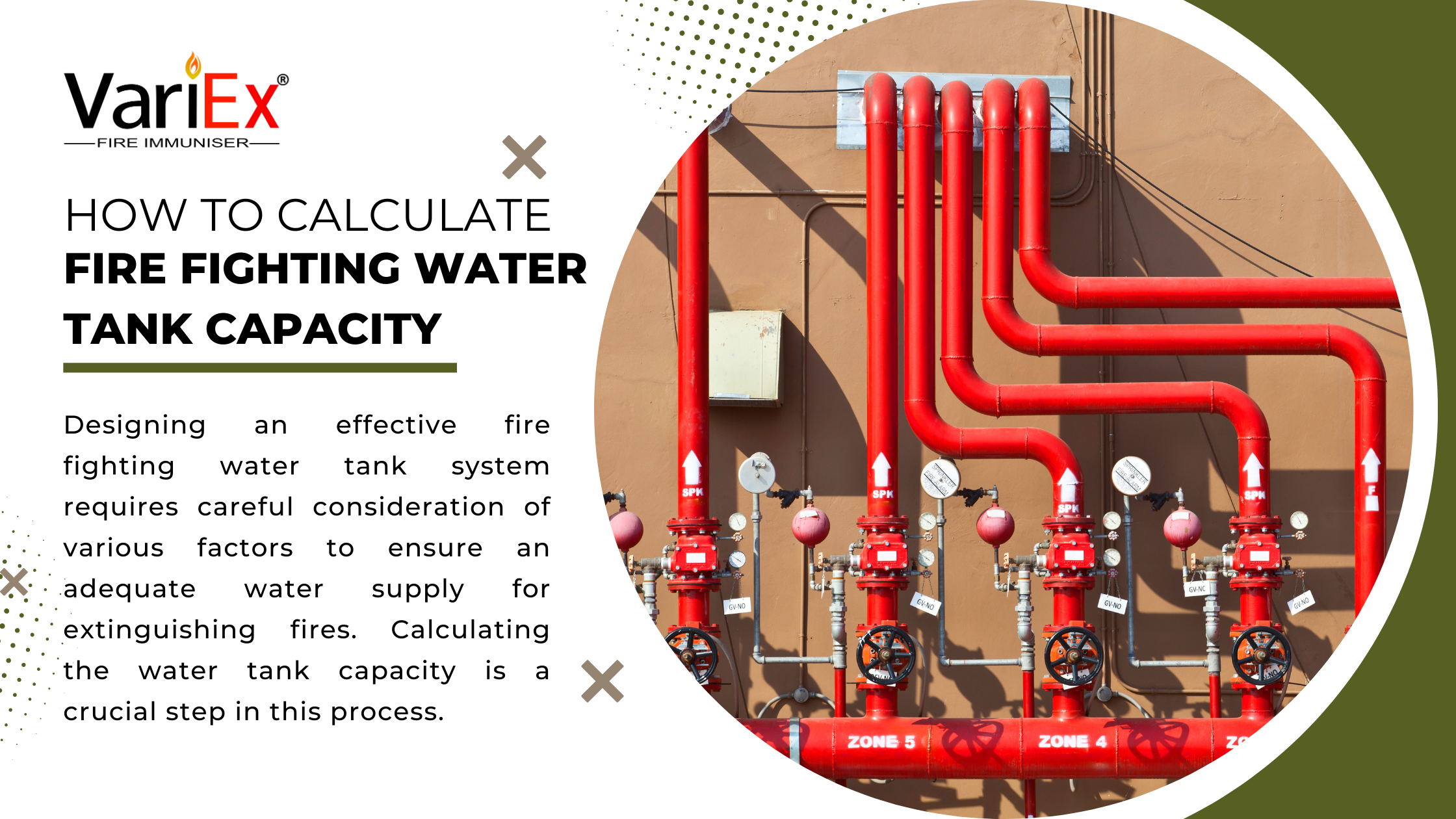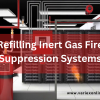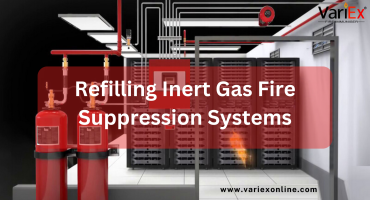![]()
Fire Immuniser
+91-7829629111
Email: info@variex.in
Varistor Technologies Pvt. Ltd.
Block-1, First Floor, Ardente Office One, Hoodi Circle, ITPL Main Road, Bengaluru, Karnataka 560048, IN
How To Calculate Fire Fighting Water Tank Capacity
Designing an effective fire fighting water tank system requires careful consideration of various factors to ensure an adequate water supply for extinguishing fires. Calculating the water tank capacity is a crucial step in this process. Here's a guide on how to calculate the capacity needed for your fire fighting water tank.
Determine Required Fire Flow Rate:
The first step is to determine the required fire flow rate, which is the amount of water needed to suppress a fire adequately. This is typically measured in gallons per minute (GPM)[GPM TO LPM CONVERTER] [LPM TO GPM CONVERTER] and depends on factors such as building size, occupancy type, and fire hazard classification. Consult local fire codes or standards to determine the required fire flow rate for your specific application.
Calculate Required Water Storage Duration:
Once you have determined the required fire flow rate, calculate the duration for which the water supply needs to be sustained during a fire incident. This is typically based on the expected duration of firefighting operations until additional water sources, such as fire hydrants or tanker trucks, can be accessed. Common durations range from one to four hours, depending on the size and occupancy of the building.
Multiply Flow Rate by Duration:
- Multiply the required fire flow rate (in GPM) [GPM TO LPM CONVERTER] by the desired duration of water supply (in hours) to calculate the total water volume needed to sustain firefighting operations. This will give you the minimum tank capacity required to meet the demand for water during a fire incident.
Consider Other Factors:
In addition to the required fire flow rate and duration, consider other factors that may impact the water tank capacity, such as:
- Fire department response time: If the response time is longer, a larger tank capacity may be necessary to provide water until firefighters arrive.
- Water availability: If the area has limited access to water sources, a larger tank capacity may be needed to compensate for delays in accessing additional water.
- Building size and hazard classification: Larger buildings or those with higher fire hazard classifications may require larger water tank capacities to meet fire suppression needs.
Account for Safety Margins:
To ensure sufficient water supply during emergencies, it is advisable to include safety margins when c alculating the water tank capacity. This accounts for uncertainties such as variations in fire intensity, equipment performance, and water demand during firefighting operations.
alculating the water tank capacity. This accounts for uncertainties such as variations in fire intensity, equipment performance, and water demand during firefighting operations.
Consult with Experts:
If you are unsure about the calculations or specific requirements for your fire fighting water tank system, consider consulting with fire protection engineers or professionals experienced in fire safety design. They can provide valuable insights and recommendations based on local regulations and industry best practices.
Example Calculation:
For instance, if the estimated firefighting flow rate is 1000 LPM:
- Required water for 30 minutes = 1000 LPM × 30 minutes = 30,000 liters.
- [LPM TO GPM CONVERTER]
Therefore, a tank with a capacity of at least 30,000 liters would be necessary to meet this demand.
By following these steps and considering the relevant factors, you can calculate the appropriate capacity for your fire fighting water tank system, ensuring adequate water supply for effective fire suppression in emergencies. Regular maintenance and testing of the water tank and associated equipment are also essential to ensure reliable performance when needed most.
Frequently Asked Questions
Fire fighting water tank capacity refers to the volume of water stored in a tank specifically designated for firefighting purposes. It is essential for ensuring an adequate water supply to suppress fires effectively and protect lives and property.
The required fire flow rate depends on factors such as building size, occupancy type, and fire hazard classification. Consult local fire codes or standards to determine the recommended fire flow rate for your specific application.
Factors to consider include the required fire flow rate, duration of firefighting operations, fire department response time, water availability, building size, and hazard classification. Safety margins should also be accounted for to ensure sufficient water supply during emergencies.
Multiply the required fire flow rate (in gallons per minute, GPM) by the desired duration of water supply (in hours) to determine the total water volume needed. Consider additional factors such as safety margins and uncertainties in fire intensity and equipment performance.
If you are uncertain about the calculations or requirements, it is advisable to consult with fire protection engineers or professionals experienced in fire safety design. They can provide expert guidance and recommendations based on local regulations and industry best practices.
Fire fighting water tank capacity calculations should be reviewed periodically to ensure they remain accurate and up-to-date. Changes in building occupancy, fire hazard classification, or regulatory requirements may necessitate updates to the calculations.
Yes, there may be local regulations, building codes, or standards that specify requirements for fire fighting water tank capacity. It is essential to adhere to these regulations to ensure compliance and adequate fire protection measures.
Regular maintenance and testing of fire fighting water tanks and associated equipment are essential to ensure reliable performance during emergencies. This includes inspections, cleaning, testing of valves and pumps, and repairs as needed.
Final Say
We at VariEx.in or Variexonline.com have mastered the art of designing, installing, inspecting, and fixing automatic sprinkler systems with the help of our in-house team, which is capable of delivering the fire sprinkler services you need, whether large or small and at affordable cost.
To schedule a fire sprinkler installation, or you think our services could benefit your commercial property, contact us online or give us a call at, 7829629111










